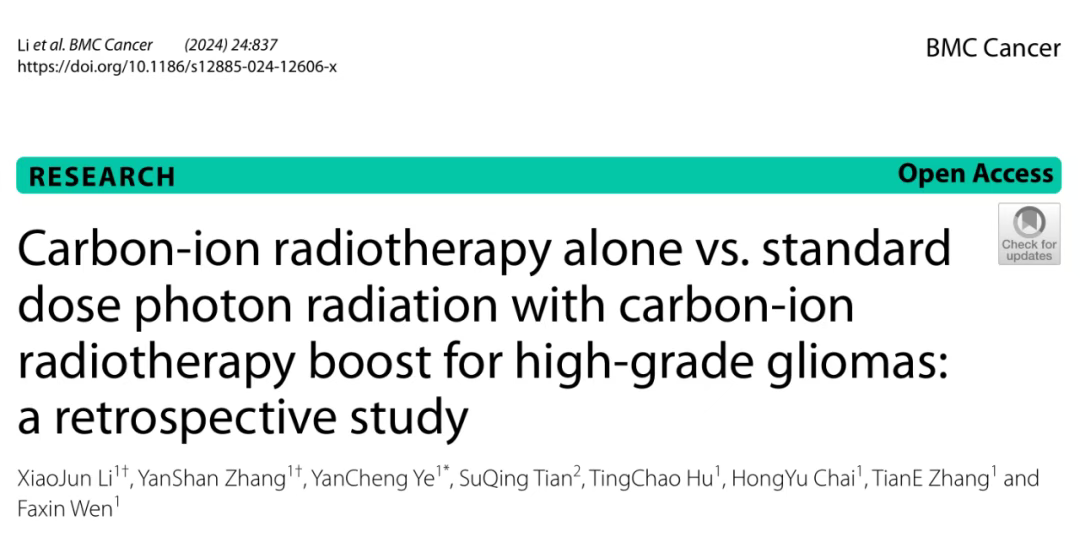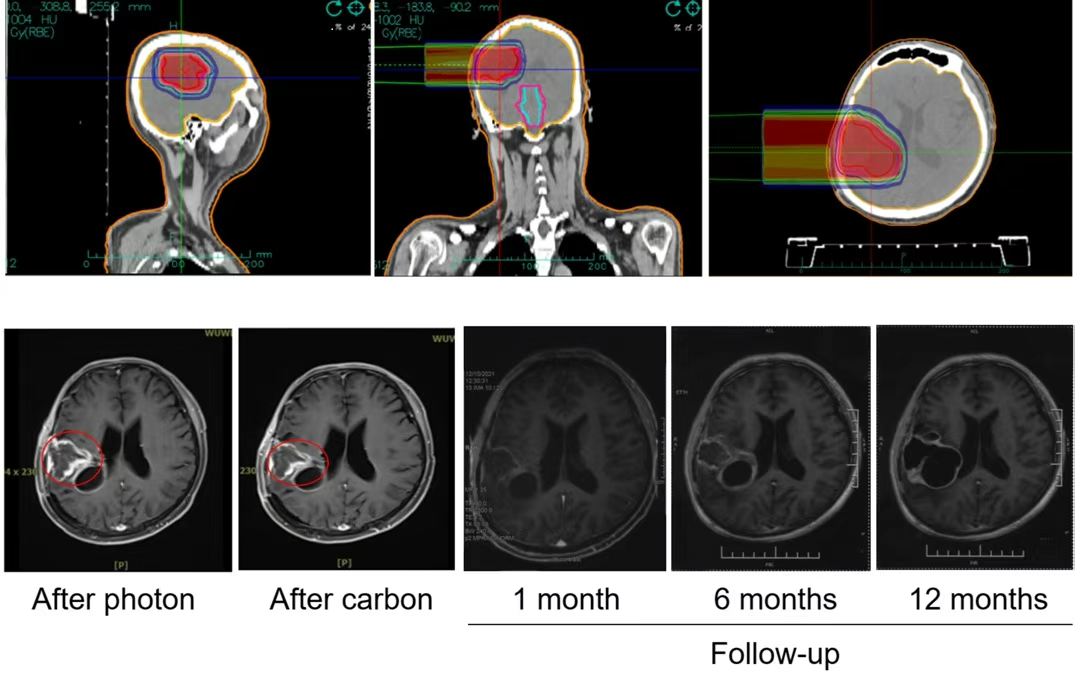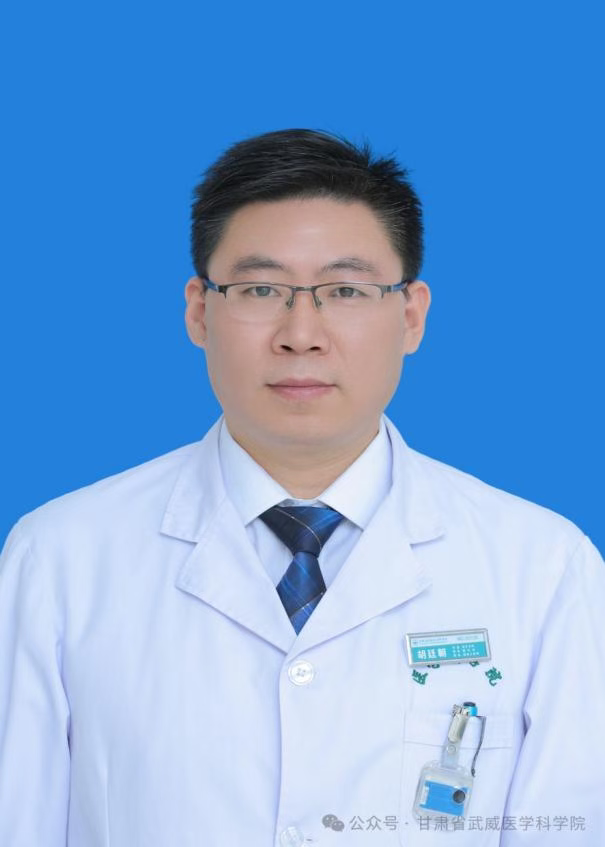Advanced Treatment for High-Grade Glioma - Heavy Ion Radiotherapy
Advanced Treatment for High-Grade Glioma - Heavy Ion Radiotherapy
Glioma is the most common primary tumor of the central nervous system. High-grade gliomas (HGG), including glioblastoma multiforme (GBM) and anaplastic astrocytoma (AA), are characterized by rapid progression and diffuse infiltration, making them one of the most aggressive malignant tumors known. Due to the radioresistance of tumor cells, conventional post-surgical treatments such as high-dose photon radiotherapy often yield suboptimal results, with recurrence rates remaining high.
Leveraging the advantages of heavy ion radiotherapy, such as its high biological effectiveness and other radiophysical and radiobiological benefits, it has shown significant efficacy in treating high-grade gliomas that are resistant to conventional radiotherapy. According to statistics, patients treated at our hospital have shown nearly double the median progression-free survival and an increase of 13.4 months in median overall survival compared to the Stupp study (conventional photon radiotherapy). The 1-year survival rate increased by 28.9%, and the 2-year survival rate increased by 31.4%, significantly higher than the 61.1% 1-year survival rate with conventional photon radiotherapy. Some patients with high-grade glioma have achieved survival periods exceeding four years. These research results were published in July 2024 in the internationally authoritative journal BMC Cancer(Impact Factor: 3.8).

Our department also utilizes the most advanced multi-modal imaging fusion technology (MRI and 11C-methionine PET/CT) for precise tumor target delineation. Combined with the physical advantages of heavy ions, this approach achieves therapeutic efficacy while effectively avoiding damage to normal brain tissues and critical nerves, significantly reducing the incidence of toxic side effects and greatly improving patients' quality of life. To date, no severe radiotherapy-related toxicities have occurred in treated patients.
Figure: Dose distribution map for a glioma patient treated with heavy ion radiotherapy, showing increased dose to the tumor area and reduced radiation damage to normal brain tissue.


Hu Tingchao, Associate Chief Physician of Radiation Oncology
● Director of the Fifth Department of Radiotherapy (Head and Neck Tumor Radiotherapy), Gansu Wuwei Cancer Hospital
● Member of the Chinese Anti-Cancer Association
● Member of the Gansu Provincial Radiotherapy Committee
● Council Member of the Third Council of the Western Radiotherapy Association
● Member of the Particle Therapy Branch of the China Association of Medical Equipment
Education and Experience: Graduated from the Clinical Medicine Department of Lanzhou University in 2005. With 18 years of experience in tumor radiotherapy, he has pursued advanced studies in radiation oncology at Sichuan Cancer Hospital, Fukuoka Tokushukai Medical Center (Japan), Shanghai Proton and Heavy Ion Center, and the Cancer Prevention and Treatment Center of Sun Yat-sen University in Guangzhou.
Specialties: 1. Expertise in comprehensive treatments including radiotherapy and chemotherapy, targeted therapy, etc., for various common malignant tumors such as head and neck tumors, glioma, lymphoma, and chordoma. 2. Precision tumor therapy: 3D Conformal Radiotherapy (3D-CRT), Intensity-Modulated Radiotherapy (IMRT), Volumetric Modulated Arc Therapy (VMAT), Stereotactic Body Radiotherapy (SBRT), Image-Guided Radiotherapy (IGRT), and Carbon Ion Radiotherapy (CIRT). Extensive experience in radiotherapy planning, protection of normal organ function, and managing radiotherapy side effects.
Research and Publications: Published over ten professional papers, authored one, holds one utility model patent, presided over the completion of two municipal-level scientific research projects in Wuwei, participated in compiling standard procedures for carbon ion radiotherapy, and has been repeatedly honored as an "Advanced Worker" by the hospital.
The Head and Neck Tumor Radiotherapy Department (Fifth Department of Radiotherapy) is a specialized ward integrating clinical practice, scientific research, and teaching. Main treated diseases include: meningioma, pituitary adenoma, acoustic neuroma, glioma, intracranial tumors, nasopharyngeal carcinoma, oral cancer, eye tumors, laryngeal cancer, hard palate cancer, hypopharyngeal cancer, chordoma, and lymphoma in various parts of the body.
Diseases particularly suitable for heavy ion therapy: Head and neck malignant melanoma, head and neck sarcoma, adenoid cystic carcinoma, recurrent head and neck cancer, skull base chordoma, chondrosarcoma, glioma.

Yin Zhaosheng
- Deputy Director of the Fifth Department of Radiotherapy, Associate Chief Physician of Radiation Oncology, Member of the Communist Party of China
- Former Director of the Radiation Oncology Department, Xiangnan University Affiliated Hospital, Hunan Province
- Standing Committee Member of the Chenzhou Medical Association Oncology Professional Committee
- Member of the Tumor Radiotherapy and Radioimmunology Professional Committee, Hunan Provincial International Medical Exchange and Promotion Association
- Member of the Clinical Nutrition Professional Committee, Hunan Medical Education Science and Technology Society
- Studied under Professor Ren Yimin, former chairman of radiotherapy in Taiwan Province, China, and Professor Wang Jinzhu, healthcare management expert at Tzu Chi Hospital in Taiwan Province, China.
- Visiting scholar at Tri-Service General Hospital and Chang Gung Memorial Hospital in Taiwan Province, China.
- Specializes in precision radiotherapy and stereotactic radiotherapy for tumors, particularly comprehensive treatment of head, neck, and neurological tumors.
